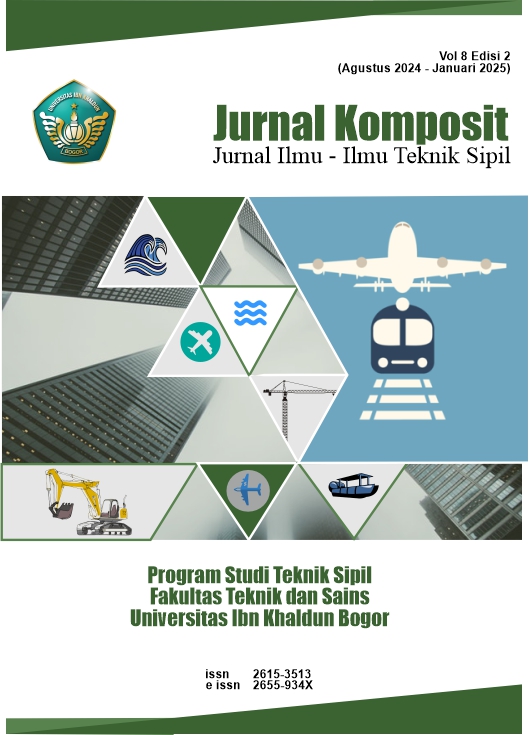Pengaruh Pemanfaatan Abu Cangkang Kerang Darah sebagai Bahan Tambah Filler Campuran Aspal terhadap Nilai Marshall pada Perkerasan Jalan AC-WC
DOI:
https://doi.org/10.32832/komposit.v8i2.15126Keywords:
Blood clam shell ash, AC-WC, Marshall Test, durabilityAbstract
Blood clam is a popular shellfish in Indonesia. Especially in Langsa because it is close to the sea area, blood cockles are found in large numbers which produce waste in the form of shells in large quantities. However, blood cockle shells contain calcium carbonate (CaCO3), which functions to bind water because water is the enemy of asphalt which can affect the age of asphalt, so the ash of blood cockle shells can be used as a filler. The aim of this test is to determine the stability and durability values due to the effect of adding blood cockle shell ash content as an additive to filler with blood cockle shell ash content of 0%, 30%, 50%, 70% and 100 %. The method used is the experimental method, namely experimental activities to obtain data. In this study, the addition of blood cockle shell ash as an added filler to the AC-WC asphalt mixture on the Marshall value showed that the greatest stability value was at 30 minutes of immersion, namely at a percentage of 50%, 1557.93 kg and the greatest stability value was at 8 hours of immersion, namely at a percentage of 50% it is 1404.40 kg. In this study, durability values were obtained based on the analysis results that at variations of 0%, 30% and 50% blood cockle shell ash content as a filler additive had the best durability values with values of 93.30%, 92.42% and 90.15% above 90% in accordance with the specifications required by the Department of Highways 2010.
Key words : AC-WC, Blood clam shell ash, Marshall, Durability
References
Abidin, Z., Bunyamin, B., & Kurniasarir, F. D. (2021). Uji Marshall pada Campuran AC-WC dengan Substitusi Filler. Jurnal Serambi Engineering, 6(1), 1631–1638. https://doi.org/10.32672/jse.v6i1.2653
Al-Mansoori, T., Dulaimi, A., Shanbara, H. K., & Musa, S. S. (2021). Marshall Parameters of Hot Mix Asphalt with Variable Filler Types and Aggregate Gradations. IOP Conference Series: Materials Science and Engineering, 1090(1), 012038. https://doi.org/10.1088/1757-899x/1090/1/012038
Asphalt Institute. (1962). Specifications and Construction Methods for Asphalt Concrete.
Esentia, A., Bahri, S., & Razali, R. M. (2014). Pengaruh Penggantian Sebagian Filler Semen dengan Kombinasi 40% Serbuk Batu Bata dan 60% Abu Cangkang Lokan pada Campuran Asphalt Concrete Binder Course (AC-BC) [Universitas Bengkulu]. https://repository.unib.ac.id/10477/
Haris, H. (2019). Analisis Pengujian Stabilitas dan Durabilitas Campuran Aspal dengan Tes Perendaman. Jurnal Linears, 2(1), 33–47. https://doi.org/10.26618/j-linears.v2i1.3026
Mawardi, M., & Sarjani, T. M. (2021). The Habitat Charactheristics of Andara granosa in the Mangrove Ecosystem in Langsa City, Aceh. Biotik: Jurnal Ilmiah Biologi Teknologi dan Kependidikan, 9(1). https://doi.org/10.22373/biotik.v9i1.8928
Rahim, A., Wihardi, W., & Muhiddin, A. B. (2012). Pengaruh Air Laut terhadap Karakteristik Perkerasan Aspal Porus yang Menggunakan Asbuton sebagai Bahan Pengikat. Jurnal Teknik Sipil, Universitas Hasanuddin Makassar.
Sari, K. I. (2021). Pengaruh Serbuk Abu Cangkang Kerang sebagai Bahan Pengganti Filler pada Campuran Aspal. JCEBT (Journal of Civil Engineering, Building and Transportation), 5(2), 132–142. https://doi.org/10.31289/jcebt.v5i2.5847
Simanjuntak, R. M., & Abugau, G. K. (2020). Pemanfaatan Filler Kapur Cangkang Kerang sebagai Pengganti Filler Abu Batu untuk Meningkatkan Durabilitas Beton Aspal terhadap Perendaman. Centech: Jurnal Rekayasa Teknik Sipil Dan Lingkungan, 1(1), 35–43. https://doi.org/https://doi.org/10.33541/cen.v1i1.1433
Sukirman, S. (1999). Dasar-dasar Perencanaan Geometrik. Penerbit Nova.
Downloads
Published
How to Cite
Issue
Section
License
Copyright (c) 2024 Jurnal Komposit: Jurnal Ilmu-ilmu Teknik Sipil

This work is licensed under a Creative Commons Attribution-NonCommercial-ShareAlike 4.0 International License.
Authors who publish with this journal agree to the following terms (Penulis yang mengajukan publikasi artikel telah menyetujui hal berikut):
- Through this publication, the author agree to submit the copyright of article writing to Jurnal Komposit: Jurnal Ilmu-ilmu Teknik Sipil. This copyright submission takes the form of, but is not limited to: reproduction of the article and parts therein, including photographic reproductions; distribution of articles through printed and electronic documents; and translation of articles(Bahwa melalui publikasi ini, hak cipta penulisan artikel diserahkan kepada Jurnal Komposit: Jurnal Ilmu-ilmu Teknik Sipil. Penyerahan hak cipta ini berupa, namun tidak terbatas pada: perbanyakan artikel dan bagian di dalamnya, termasuk reproduksi fotografi; penyebarluasan artikel melalui dokumen cetak dan elektronik; serta penterjemahan artikel).
- The authors agree to the terms of the Copyright Notice, according to Creative Commons Attribution-NonCommercial-ShareAlike 4.0 International License., which will apply to this article if and when it is published by Jurnal Komposit: Jurnal Ilmu-ilmu Teknik Sipil. (Para penulis setuju dengan ketentuan Pemberitahuan Hak Cipta, sesuai dengan Lisensi Internasional Creative Commons Attribution-NonCommercial-ShareAlike 4.0., yang akan berlaku untuk artikel ini jika dan ketika diterbitkan oleh Jurnal Komposit: Jurnal Ilmu-ilmu Teknik Sipil).

This work is licensed under a Creative Commons Attribution-NonCommercial-ShareAlike 4.0 International License.



.png)










